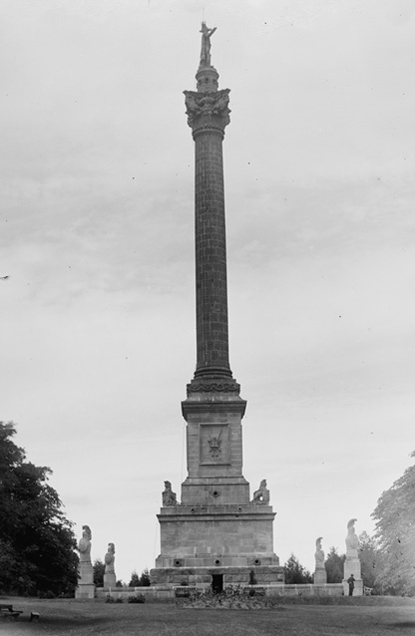In the Canadian mind of the 1800s, the theme that self-sacrifice lead to Canadian victory in a fight against overwhelming odds was personified in Major-General Sir Isaac Brock, the British general whose heroic death at the battle of Queenston Heights in October 1812 caused him to be termed “the saviour of Upper Canada.” It also led to the construction of the most impressive Canadian memorial of the war.
A hero who at the foot of these heights died a hundred years ago while leading Canadian volunteers to drive back invaders who without just cause had dared to come to Canada with the avowed purpose of forcibly taking possession of our country. Description of Isaac Brock at the centennial celebration of the Battle of Queenston Heights

Library of Congress, Prints and Photographs Division
As early as 1814, the Legislative Assembly of Upper Canada had proposed the erection of a memorial to Sir Isaac Brock, and it was duly built and consecrated ten years later. A Tuscan column, 135 feet high with a viewing platform, it was situated atop Queenston Heights, not far from where Brock was killed. In 1840 anti-British agitators blew up this memorial, but almost immediately steps were taken to erect a new and more impressive monument to the fallen hero. This took the form of a 184-foot-high column surmounted by a larger-than-life statue of the general and supported by an ornate base festooned with panoplies of arms in the style of the ancient Greeks, another of those classical allusions so beloved of Victorian society.
When completed in 1856, this column was one of the highest structures in the world and a fitting tomb for Brock, whose remains are interred in its base. Placed on the brow of the Niagara escarpment overlooking the Niagara River that is the border between Canada and the United States, it can be seen for miles and towers over the surrounding countryside, including the neighbouring part of New York State. This physical dominance was deliberate for, as one modern Canadian historian has remarked, Brock’s splendid memorial testified, in a most visible way (especially to Americans on the other side of the river), the veneration of Upper Canadians for the man deemed responsible for their survival; as James Hannay later wrote: “the lofty column erected to his memory informs the whole world that patriotism still lives in Canada.”
In the late 1800s, other memorials were erected in Canada to mark the location of such major battles as Chateauguay, Crysler’s Farm, and Lundy’s Lane, but the arrival of the centennial in 1912 witnessed an outpouring of patriotic celebration in Canada. It was the high noon of the British Empire, and Canada was proud to be a prominent member of that empire. That this was so was made clear by an official of the Ontario Department of Education speaking at the 100th anniversary of the battle of Queenston in October 1912. Stressing that the ceremony was being held to pay:
due tribute to the brave men and women who so nobly and heroically struggled to preserve for us the blessing of British liberty, and of unity with our motherland. To these men and women of firm faith and strong heart, we give gratitude and reverence today, and especially to the statesman and hero who at the foot of these heights died a hundred years ago while leading Canadian volunteers to drive back invaders who without just cause had dared to come to Canada with the avowed purpose of forcibly taking possession of our country.
Part of a series of articles titled The War of 1812 in Canadian Memory .
Last updated: August 15, 2017
